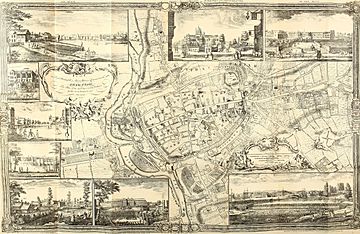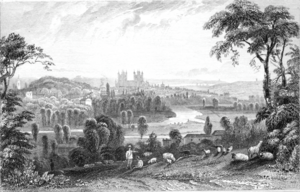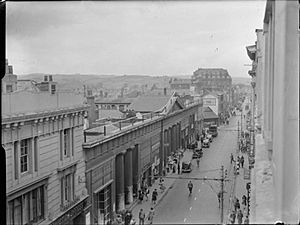Timeline of Exeter facts for kids
Exeter is an important city in Devon, England. This page shares a timeline of its long and interesting history. A timeline helps us see how a place has changed over many years, from ancient times to today.
Exeter's Early History (Before 16th Century)
- Around 250 BC: People in Exeter were trading goods using Roman coins, even before the Romans officially arrived.
- Around 45 CE: The Romans took control of the area.
- Around 55 CE: The Romans built a fort in a place they called Isca Dumnoniorum, which is now Exeter.
- Around 380 CE: The Romans left Exeter.
- Around 600 CE: The Saxons, another group of people, arrived in the area.
- 868: A monastery was started by Ethelred.
- 876: The Danes (Vikings) took over the town.
- 893: The Danes attacked Exeter again.
- 900: A busy market was active in the town.
- 927: King Athelstan made the Cornish people leave Exeter.
- 932: King Athelstan founded another monastery.
- 1003: Exeter was attacked and looted by forces led by Sweyn Forkbeard from Denmark.
- 1048: The main church office (called an Episcopal see) for the area moved to Exeter from Crediton.
- 1050: Leofric became the first Bishop of Exeter.
- 1067: William the Conqueror and his army attacked Exeter.
- 1068: Rougemont Castle was built.
- 1087: The Benedictine Priory of St Nicholas was founded.
- 1130: A fair, where people could buy and sell goods, was active in Exeter.
- 1136: Exeter was attacked by forces loyal to Stephen, King of England.
- 1190: Work began on the Old Exe Bridge.
- 1207: Exeter got its first mayor.
- 1214: The Old Exe Bridge was finished.
- 1236: A nunnery (a place for nuns) was founded.
- 1400: The famous Exeter Cathedral was mostly built around this time.
- 1468/70: The current Exeter Guildhall building was constructed.
- 1497: The city was attacked by forces of Perkin Warbeck, who claimed to be a prince.
Exeter in the 16th to 18th Centuries

John Rocque's 1744 map of Exeter
- 1536:
- Exeter became a "county corporate," meaning it had more control over its own laws.
- The monastery in Exeter was closed down as part of the Dissolution of the Monasteries.
- 1556: The Society of Merchant Adventurers was formed to help with trade.
- 1564: Construction began on the Exeter Ship Canal, which helped ships reach the city.
- 1593: The Guildhall building was rebuilt.
- 1612: Northernhay Gardens were created.
- 1633: The Exeter Free Grammar School opened.
- 1643: In September, the city was taken by the King's forces during the First English Civil War.
- 1646: In April, the Parliamentarians (who fought against the King) took control of Exeter.
- 1664: St Stephen's Church was built.
- 1681: The Custom House was built on the Quay, where taxes on goods were collected.
- 1688: In November, William III of England visited the city.
- 1696: A mint, where coins were made, was set up in Exeter.
- 1714: The Exeter Mercury newspaper started publishing.
- 1743: The Royal Devon and Exeter Hospital opened to care for the sick.
- 1760: George's Meeting, a Unitarian church, was built.
- 1763: The Trewman's Exeter Flying Post newspaper began publication.
- 1764: The Exeter Synagogue was opened for Jewish worship.
- 1778: The main bridge in Exeter was rebuilt.
- 1792: The Exeter Gazette newspaper started.
Exeter in the 19th Century
- 1813: The Devon and Exeter Institution was founded, a place for learning and research.
- 1814: An Iron Footbridge was built.
- 1823: A cholera epidemic affected the city.
- 1825: The Mechanics' Institution opened, offering education to working people.
- 1837: Catacombs (underground burial places) were built.
- 1840: The Exeter Diocesan Training College opened, training teachers.
- 1844: The Bristol and Exeter Railway started running trains to Exeter St Davids railway station.
- 1848: The South Devon Railway also began operating from Exeter St Davids station.
- 1853: Exeter Prison was built.
- 1854: The School of Art was founded.
- 1860: The London and South Western Railway started service to Exeter Queen Street station.
- 1870: The Royal Albert Memorial Museum was established.
- 1882: Horse-drawn trams began operating in the city.
- 1884: The Sacred Heart Church opened on November 18.
- 1887: On September 5, the Theatre Royal burned down, sadly killing 186 people.
- 1889: The Theatre Royal was rebuilt.
Exeter in the 20th Century
- 1901: The population of Exeter was 47,185 people.
- 1904: The Express & Echo newspaper began publication.
- 1905:
- On March 29, the rebuilt Exe Bridge opened.
- On April 4, the Exeter Corporation Tramways started running its electric tram system.
- 1910: The Empire Electric Palace cinema opened.
- 1914: On October 7, the first of five war hospitals opened in Exeter to treat injured soldiers.
- 1937:
- The Odeon Exeter cinema opened.
- Exeter Airport opened.
- 1942: In May, during World War II, German planes bombed the city in what was known as the "Baedeker Blitz," causing a lot of damage to the city centre.
- 1949: On October 21, work officially began on Princesshay, which became Britain's first shopping area just for pedestrians (people walking).
- 1955: The University of Exeter was officially recognized.
- 1960: In October, the city experienced a flood.
- 1963: In November, the Exeter & Devon Crematorium opened.
- 1964: Devon County Hall was built.
- 1966: On April 1, Exeter's city boundaries grew to include Alphington, Pinhoe, and Topsham.
- 1967: The Northcott Theatre opened.
- 1970: Exeter College was established.
- 1977: The M5 motorway opened, improving road connections.
- 1997: The Douglas Centre for the History of Cinema and Popular Culture opened at the University of Exeter.
Exeter in the 21st Century
- 2007: The Princesshay shopping area was rebuilt and updated.
- 2008: On May 22, there was an attempted incident in Princesshay.
- 2011: The population of Exeter was 117,773 people.
- 2017: The Exeter Chiefs rugby union team won the Aviva Premiership championship.
- 2021: A World War II bomb found in the city was safely detonated.

All content from Kiddle encyclopedia articles (including the article images and facts) can be freely used under Attribution-ShareAlike license, unless stated otherwise. Cite this article:
Timeline of Exeter Facts for Kids. Kiddle Encyclopedia.




